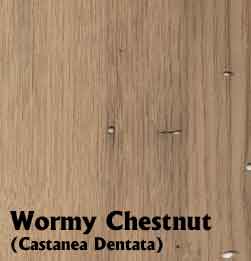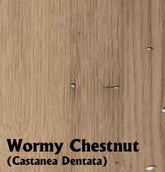

Wormy Chestnut
Wormy Chestnut (Castanea dentata) Caused by an accidentally introduced Asian bark fungus (Cryphonectria parasitica), the chestnut blight of the early 1900s was responsible for killing over three billion chestnut trees. The wood in these standing trees was subsequently damaged by insects, leaving holes and discoloration. The trees were then subsequently harvested and converted into lumber (called Wormy Chestnut). Between the nail holes, discoloration, worm and insect damage, Wormy Chestnut is preferred in applications where a rustic or unpolished appearance is desired.
Because of the blight wiping out nearly all mature American Chestnut trees, its lumber is both rare and (relatively) valuable. Wormy Chestnut in particular is usually salvaged from old barns and other structures, and reprocessed and sold as reclaimed lumber. Prices are likely to be high for a domestic hardwood.
Chestnut is rated as very durable against rot. The heartwood is a light to medium brown, darkening to a reddish brown with age. Narrow sapwood is well-defined and is pale white to light brown. Chestnut was once commonly used for building houses, barns, furniture & many more applications. Today most chestnut is used for repair work and special projects due to limited availablity and cost.
|
Botanical Name |
Castanea dentata |
| Origin | Eastern United States |
| Janka Hardness | 540 lbf |
| Average Dried Weight | 30 lbs/ft3 |
| Workability | Works nicely with hand and machine tools. Chestnut splits easily, so care must be taken in nailing and screwing the wood. Glues, stains, and finishes well. |
| Related Species | Sweet Chestnut (Castanea sativa) |
Wormy Chestnut
4/4
4050 Old Cornelia Hwy
Gainesville GA 30507
United States
Wood Calculator Section
Need Help Figuring out how much you need ?
One Board foot = 144 Cubic Inches
Example: If you need a piece of wood 12 inches wide, 1 inch thick and 24 inches long, that is equal to 2 board feet.
12 inches x 1 inch x 24 inches = 288 inches. 288/ 144 = 2 board feet


